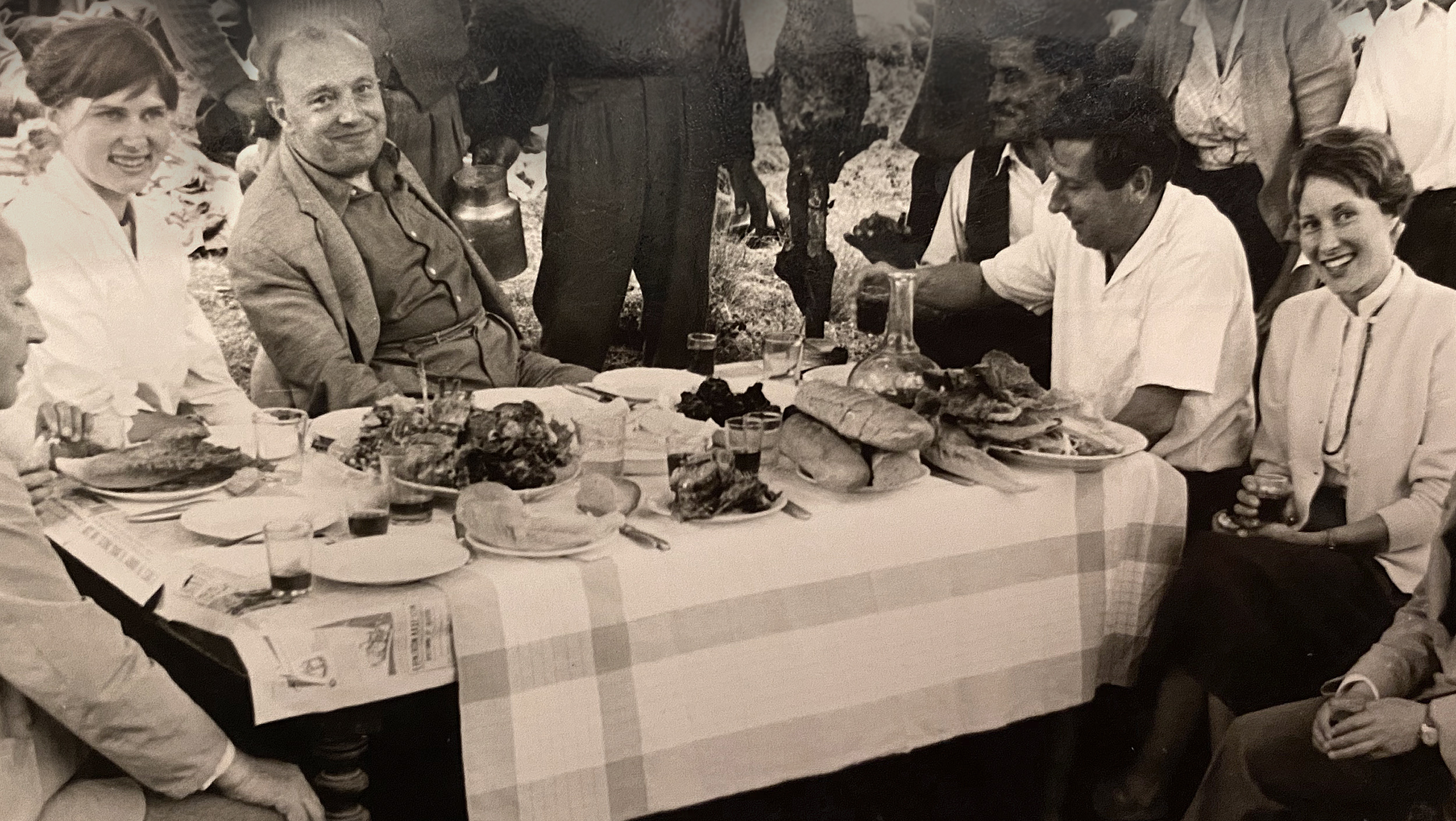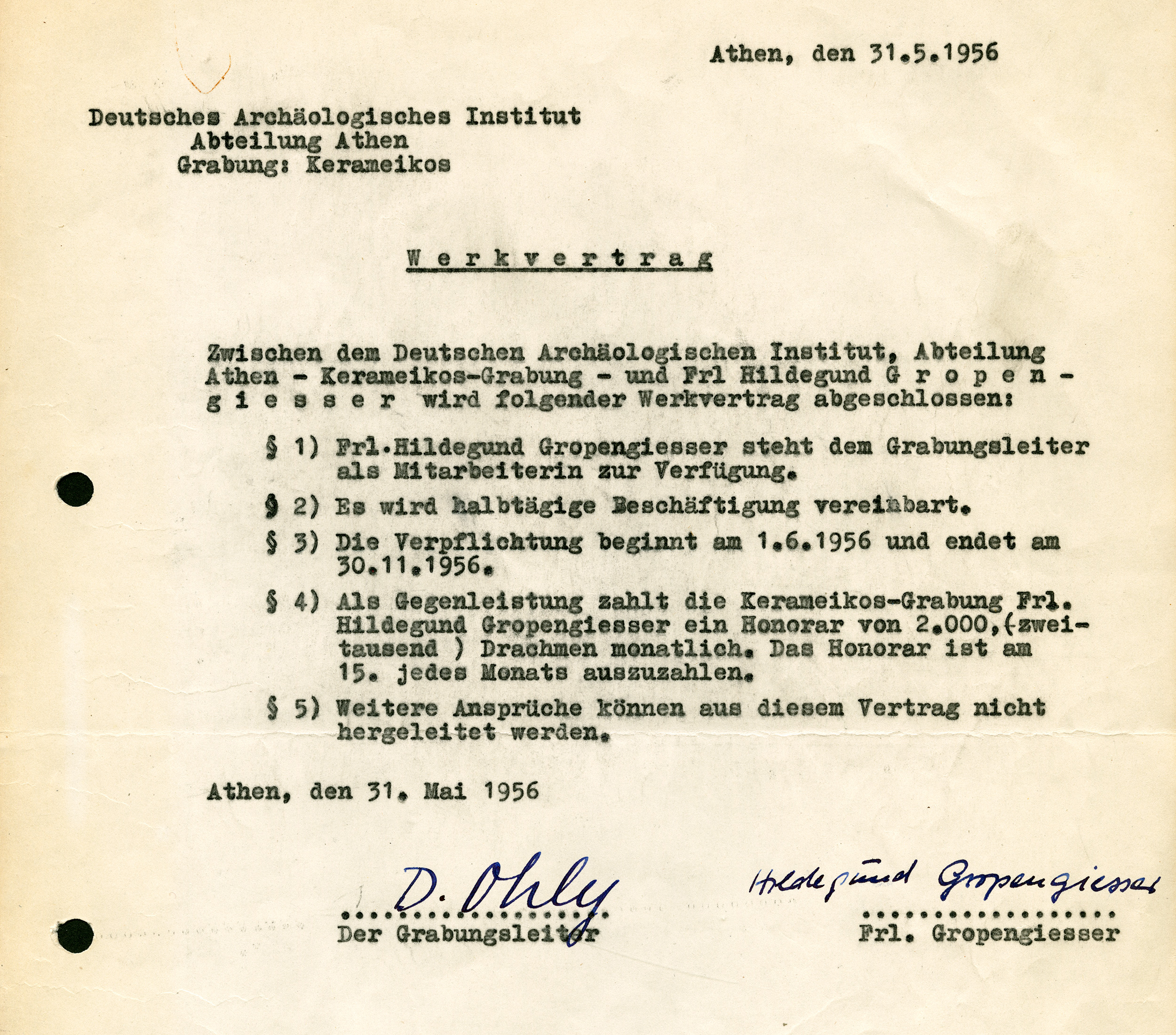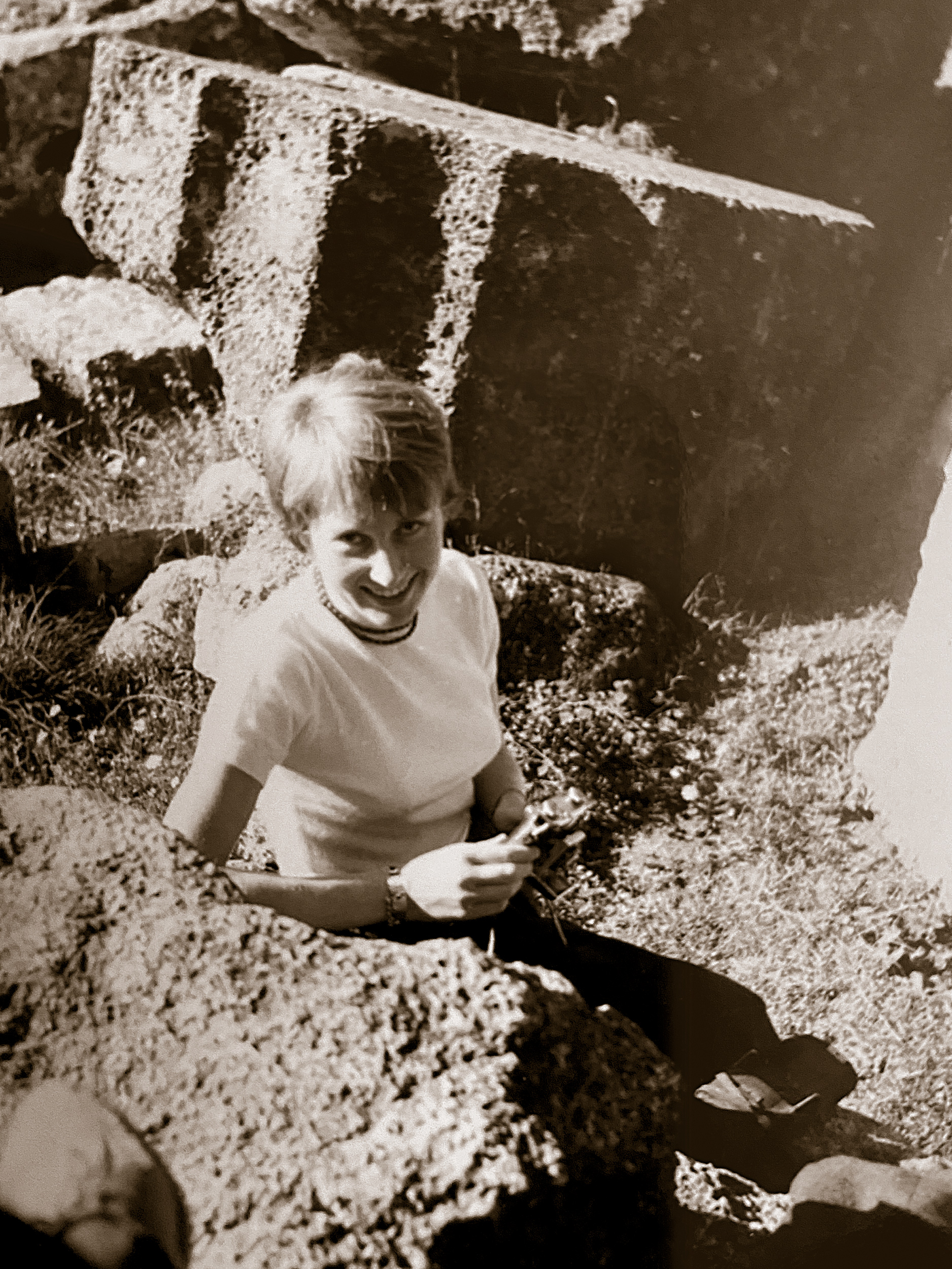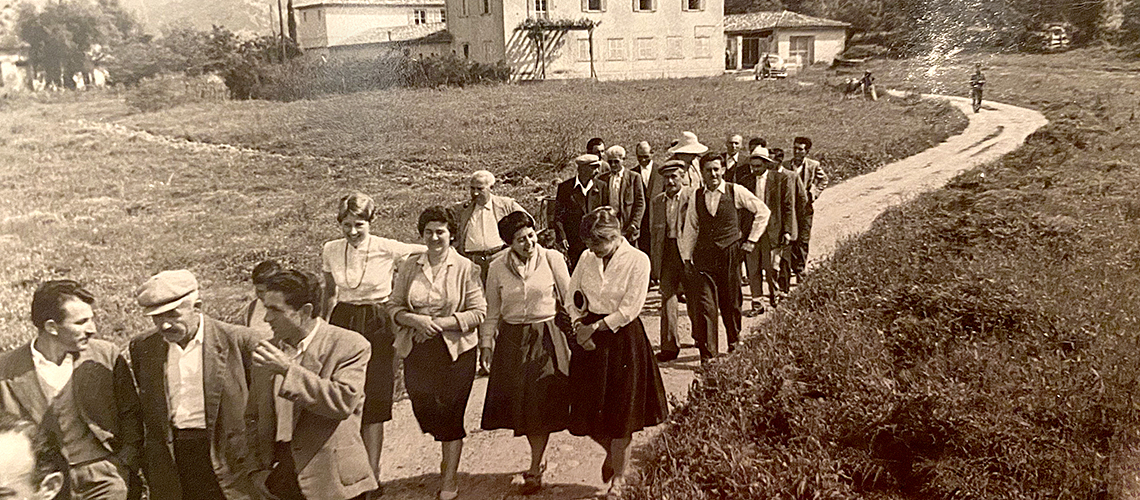Hildegund Gropengiesser (*Jan. 15th 1928, †June 16th 2019) was one of the first female German archeologists to participate actively in field campaigns in Greece. She witnessed the reopening of the Athens Department of the DAI after WWII and was one of the first German women to have a successful career as a classical archeologist.
She first came into contact with the DAI Athens in 1953, before she had completed her PhD in 1958. This connection lasted long afterward and will be sketched here – not least with the help of the testimony of her colleague, traveling companion, and friend Erika Kunze-Goette.
On the occasion of Gropengiesser’s funeral, Kunze-Goette gave a personal account of her colleague from the early days of classical archeology (fig. 1), which we will put into context and illustrated with historical documents from the archives of the DAI.

“Hildegund had gone to Athens already as an exchange student. She initially lived in a Greek dormitory and worked on her dissertation about floral acroteria from the classical period, with which she earned her PhD in Heidelberg under Reinhard Herbig.” (Erika Kunze-Goette)
This information is confirmed by the annual reports for the years 1953–1954 and 1954–1955, which are preserved in the departmental archive in Athens. “Fräulein doctoral candidate Gropengiesser” is recorded as one of the Germans studying as exchange students in Athens whom “the Institute is looking after”. It is also mentioned that she was helping “as an aide paid by the hour” with the reconfiguration of the photograph collection, which had just started at the time. She evidently was considered to be so reliable that, beginning in October 1954, she served as acting academic head of the library instead of Alfred Mallwitz, while he was on leave. In autumn 1955, after the departure of Ulrich Hausmann, she filled in as acting head of the photographic archive until Hausmann’s designated successor, Hagen Biesantz, took his place at the beginning of 1956. Although she could not hold these positions herself before completing her PhD, she used this time to demonstrate her scholarly qualifications. She received permission from the Ephoros, Dr. Joannis Papadimitriou, to publish “a new fragment from the west pediment of Epidaurus” (Gropengiesser 1954/1955).
She subsequently took part in her first excavation, namely, in the Kerameikos under the direction of Dieter Ohly, from 1 June to 30 November 1956 (fig. 2).

Gropengiesser completed her PhD in 1958 and received the prestigious travel grant of the DAI. Kunze-Goette, who likewise was awarded the grant in 1958–1959, remembered:
“We received the great gift of the travel grant of the German Archeological Institute in the same year (1958), and we usually traveled together in a Volkswagen Beetle that the Institute had made available for us. Since I was initially in England and Paris, we met in southern France – where the adventurous Hildegund had driven the car with her new driver’s license which (like myself) she had acquired specifically for the trip. Neither of us had seen as much as students today do and so we concentrated on the classic tour of Italy, Greece, and Turkey – although, for the Turkey trip, only a general tour with all the grantees led by the Institute in Istanbul was allowed. I cannot describe in detail here the many unforgettable experiences we shared. After that year, we both – along with the Volkswagen – were dispatched to Olympia as assistants at the large, very intense and fruitful excavation of the north slope of the stadium.”
The work contracts for the period from September 9th to December 31st, 1960, survive today in the Athens archive. It describes Gropengiesser and Kunze-Goette’s responsibilities as the “scholarly supervision of the excavation works, visual inspection and inventarization of finds, etc.”
Ms. Kunze-Goette, to whom we are indebted for the photographs below, describes everyday life at the excavation far more vividly:
“Hildegund’s primary job was to sketch the finds for the excavation inventory. She was a very good and also very learned sketch artist and knew how to make the usually heavily battered pieces instantly recognizable. We lived in a room together in the old excavation building for a good year and a half. Our only comfort was a small tin washbasin with a tin canister over it that could be filled with water. We didn’t mind at all. We were young and absorbed in our activities in connection with that great project. My job was primarily to sort and classify the small finds that the workers carried every evening into the courtyard in a large number of wooden boxes. Many significant pieces from the wealth of large finds made at this excavation are exhibited today in the Museum of Olympia.” (Fig. 3)

The conclusion of the north slope excavation at the stadium in 1960 was celebrated with a large excavation banquet (fig. 1 and fig. 4). The photographs of the “glenti” (Greek for feast) were taken by a local photographer, who displayed and sold them later in the village.

Gropengiesser inherited her close ties to Greece and archeology practically from birth. Her father, Hermann Gropengießer, had been in Greece in 1906 and earned his PhD with a dissertation on “The Tombs of Attica of the Pre-Mycenean and Mycenean Ages.” He was elected a corresponding member of the DAI in 1922 and an ordinary member in 1923.
After Gropengiesser was able to put her career on firm footing with a permanent position in the antiquities collection of the University of Heidelberg (for details about this aspect of her life, see Hölscher 2021), she was elected a corresponding member of the DAI in 1974.
That was by no means the end of her relationship with Greece or the DAI in Athens. Later trips and her work on Siphnos resulted in two extensive articles in Athenische Mitteilungen on prehistoric mining (Gropengiesser 1986 and 1987). The scholarly breadth of her publications stretches chronologically from prehistory to the classical period and thematically from building ornamentation to fine and coarse pottery. She shared her extensive knowledge with students at Heidelberg in her seminars on potsherds. She spent her free time, when she could, in Greece. Erika Kunze-Goette remembers:
“Later, when Hildegund was the custodian of the antiquities collection in Heidelberg and I was married, she often stayed with us in Greece. The summer weeks there were indispensable for my Athens-born husband, and that suited mine and Hildegund’s wishes very well. Hildegund came – at the time, before there were regular flights – with her own car so that we drove through the Balkans in a convoy, which was not always without incident! Hildegund and I sat for hours in the midsummer heat and sun somewhere out in the countryside or by the sea, engrossed in our beloved pastime of painting landscapes in watercolor. Hildegund was a true master at it, and I was her eager student.”
Works cited and further reading:
Gropengiesser 1954/1955
Gropengiesser, Ein neues Bruchstück zum Westgiebel von Epidauros, in: AM 69/70, 1954/1955, 105–107
Gropengiesser 1961
Gropengiesser, Die pflanzlichen Akrotere klassischer Tempel (Mainz 1961)
Gropengiesser 1986
Gropengiesser, Siphnos, Kap Agios Sostis. Keramische prähistorische Zeugnisse aus dem Gruben- und Hüttenrevier 1I, AM 101, 1986, 1–39
Gropengiesser 1987
Gropengiesser, Siphnos, Kap Agios Sostis. Keramische prähistorische Zeugnisse aus dem Gruben- und Hüttenrevier II, AM 102, 1987, 1–54
Hölscher 2021
Hölscher – Gastbeitrag, Hildegund Gropengiesser (1928–2019) und die Antikensammlung der Universität Heidelberg, Das Rollpodest (Online-Edition) 13.01.2021, aktualisiert 19.01.2021, aufgerufen: 2.3.2022)
https://rollpodest.hypotheses.org/631
Hildegund Gropengiesser – Wikipedia entry (in German)
https://de.wikipedia.org/wiki/Hildegund_Gropengiesser
